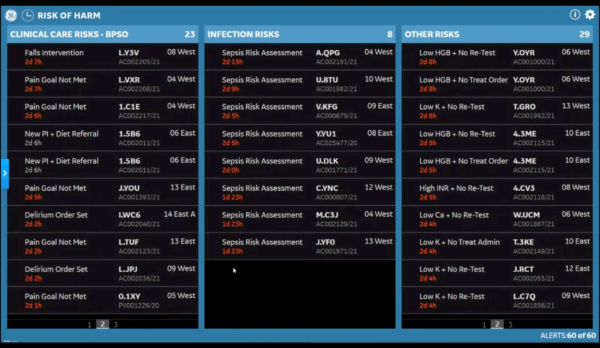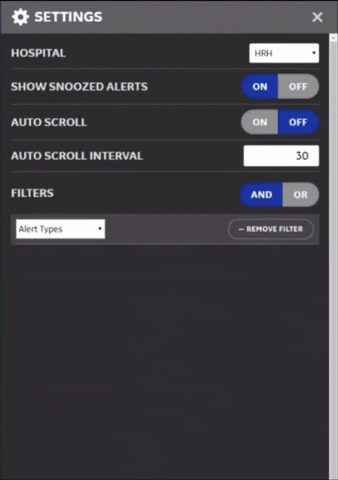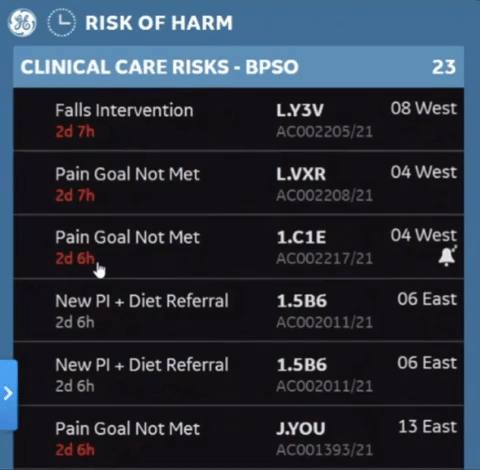Command Centre Clinical Tile Series: Risk of Harm
04
Aug
2020
 The Risk of Harm tile was created to monitor patients that have an elevated risk of harm and minimize potential safety threats. Through the electronic medical record (EMR), the tile ensures that the appropriate tests and treatments are administered in a timely manner. This tile incorporates artificial intelligence to detect the onset of conditions such as sepsis or infection. This allows staff, specifically nurses, to reduce the likelihood of such conditions to progress. Below is a sample of a Risk of Harm tile that is displayed at the Command Centre.
The Risk of Harm tile was created to monitor patients that have an elevated risk of harm and minimize potential safety threats. Through the electronic medical record (EMR), the tile ensures that the appropriate tests and treatments are administered in a timely manner. This tile incorporates artificial intelligence to detect the onset of conditions such as sepsis or infection. This allows staff, specifically nurses, to reduce the likelihood of such conditions to progress. Below is a sample of a Risk of Harm tile that is displayed at the Command Centre.
The Risk of Harm tile has the ability to track any discrepancies between practice on the floor and the individual care plans determined by the hospital. If any deviations are detected from their plan, it is flagged by the systems AI and alerted to the Command Centre staff. Similar to every other tile, each tile can be customised based on what the user desires to see. Staff can filter for alert type, location or units depending on what they are responsible for. For example, if the user is in charge of monitoring a particular floor or is the Most Responsible Physician (MRP) for that area, they can filter results to see patients within those given locations. Another example would be a specialist applying a filter to only view patients that have been identified as being at risk of delirium. This ensures that staff can focus on their specific subset of patients and avoid being overwhelmed with data they do not require at that particular time.

There are three categories of alerts within the Risk of Harm tile:
Clinical Care Risks (BPSO): These alerts monitor nursing standards of care which are documented on the electronic medical record (EMR), at the point of care by front line providers. Each row within the tile represents a patient, followed by where they are located. By clicking on a patient, you are able to see more information regarding the clinical criteria that put them on the tile. With every patient, there is an expected time in which the issue should be resolved based on a service level set by the hospital. If the systems AI detects that the process is taking longer than expected, the icon will escalate to amber and then to red, indicating a higher level of alert.

Infection Risks: This section of the tile displays patients in the hospital that have specific infection risks. In this sample case, the user was interested in seeing patients that are deviating from their sepsis care plan. Especially during the current pandemic, these pathways are very important in the timely treatment of infectious diseases to ensure optimal patient recovery.
Other Risks: This last column of the tile identifies other risks that patients may exhibit. By utilising AI, the sample tile indicates that laboratory testing has appeared to yield abnormal results to what the hospital has established as normal. The Command Centre and staff on the front line are alerted that action is required through the tile and the electronic medical record (EMR), respectively.

The Risk of Harm tile is designed to decrease the possibility of events for patients who are at a greater risk of harm. With the implementation of evidence-based care by Registered Nurses’ Association of Ontario (RNAO) in conjunction with key technologies, the Command Centre staff are able to carefully focus on a subset of alerts that aid in identifying potential safety threats.
